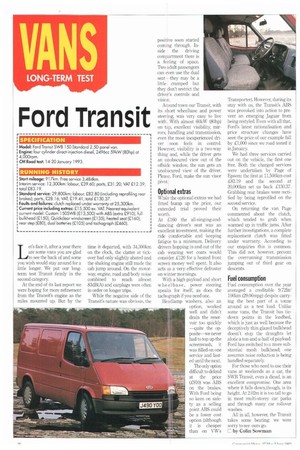Ford Transit
Page 22

If you've noticed an error in this article please click here to report it so we can fix it.
]Let's face it, after a year there are some vans you are glad to see the back of and some you wish would stay around for a little longer. We put our longterm test Transit firmly in the second category
At the end of its last report we were hoping for more refinement from the Transit's engine as the miles mounted up. But by the time it departed, with 34,300km on the clock, the clatter at tickover had only slightly abated and the shaking engine still made the cab jump around. On the motorway, engine, road and body noise combined to reach almost 83dB(A) and earplugs were often in order on longer trips.
While the negative side of the Transit's nature was obvious, the
positive soon started coming through. Inside the driving compartment there is a feeling of space. Two adult passengers can even use the dual seat -they may be a little cramped but they don't restrict the driver's controls and vision
Around town our Transit, with its short wheelbase and power steering, was very easy to live with. With almost 60kW (80hp) on tap, excellent visibility, mirrors, handling and transmission, even the most inexperienced driver soon feels in control. However, visibility is a two-way thing and, while the driver gets an unobscured view out of the offside window, the sun gets an unobscured view of the driver. Please, Ford, make the sun visor pivot.
Optional extras
While the optional extras we had fitted bump up the price, our extended trial proved their worth.
At .£160 the all-singing-anddancing driver's seat was an excellent investment, making the ride comfortable and keeping fatigue to a minimum. Delivery drivers hopping in and out of the cab wearing wet coats would consider £120 for a heated front screen money well spent. It also acts as a very effective defroster on winter mornings.
With a high payload and short wheelbase, power steering speaks for itself, as does the tachograph if you need one.
Headlamp washers, also an option, worked well and didn't drain the reservoir too quickly —quite the opposite—we never had to top up the screenwash, it was filled on one service and lasted until the next.
The only option difficult to defend at the price (1910) was ABS on the brakes. With Ford being so keen on safety as a selling point ABS could be a lower cost option (although it is cheaper than on VW's Transporter). However, during its stay with us, the Transit's ABS was provoked into action to prevent an emerging Jaguar from being restyled. Even with all that, Ford's latest rationalisation and price structure changes have seen the price of our example fall by £1,000 since we mad tested it in January.
We had three services carried out on the vehicle, the first one free. Both the charged services were undertaken by Page of Epsom: the first at 11,500km cost £83.19 and the second at 20,000km set us back £130.37. Grabbing rear brakes were rectified by being reprofiled on the second service.
On returning the van Page commented about the clutch, which tended to grab when warmed up in traffic jams. After further investigations, a complete replacement clutch was fitted under warranty According to our enquiries this is common. This did not, however, prevent the overrunning transmission jumping out of third gear on descents Fuel consumption Fuel consumption over the year averaged a creditable 9.721it/ 100km (29.06mpg) despite carrying the best part of a tonne around as a test load. Unlike some vans, the Transit has tiedown points in the loadbed, which is just as well because the deceptively thin glazed bulkhead doesn't stop the draughts let alone a ton-and-a-half of payload. Ford has switched to a more substantial mesh bulkhead; one assumes noise reduction is being handled separately.
For those who need to use their vans at weekends as a car, the SWB Transit, even a diesel, is an excellent compromise. One area where it falls down,though, is its height. At 2.02m it is too tall to go in most multi-store v car parks and through many car rollover washes.
All in all, however, the Transit takes some beating: we were sorry to see ours go.
E by Colin Sowman




















































































